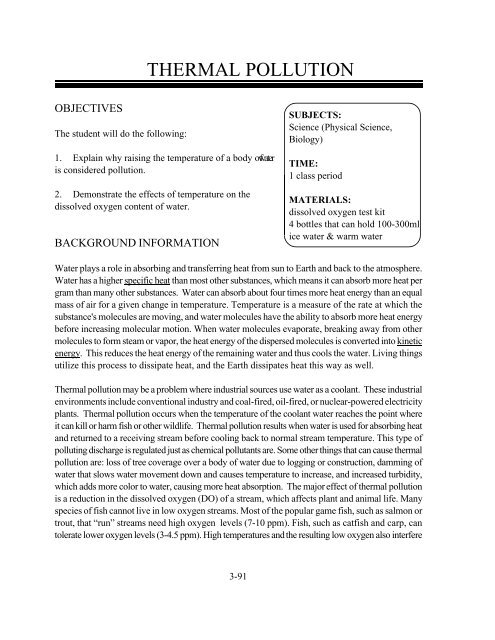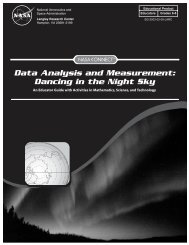BIOGRAPHY OF A RIVER
BIOGRAPHY OF A RIVER
BIOGRAPHY OF A RIVER
Create successful ePaper yourself
Turn your PDF publications into a flip-book with our unique Google optimized e-Paper software.
THERMAL POLLUTIONOBJECTIVESThe student will do the following:1. Explain why raising the temperature of a body of wateris considered pollution.2. Demonstrate the effects of temperature on thedissolved oxygen content of water.BACKGROUND INFORMATIONSUBJECTS:Science (Physical Science,Biology)TIME:1 class periodMATERIALS:dissolved oxygen test kit4 bottles that can hold 100-300mlice water & warm waterWater plays a role in absorbing and transferring heat from sun to Earth and back to the atmosphere.Water has a higher specific heat than most other substances, which means it can absorb more heat pergram than many other substances. Water can absorb about four times more heat energy than an equalmass of air for a given change in temperature. Temperature is a measure of the rate at which thesubstance's molecules are moving, and water molecules have the ability to absorb more heat energybefore increasing molecular motion. When water molecules evaporate, breaking away from othermolecules to form steam or vapor, the heat energy of the dispersed molecules is converted into kineticenergy. This reduces the heat energy of the remaining water and thus cools the water. Living thingsutilize this process to dissipate heat, and the Earth dissipates heat this way as well.Thermal pollution may be a problem where industrial sources use water as a coolant. These industrialenvironments include conventional industry and coal-fired, oil-fired, or nuclear-powered electricityplants. Thermal pollution occurs when the temperature of the coolant water reaches the point whereit can kill or harm fish or other wildlife. Thermal pollution results when water is used for absorbing heatand returned to a receiving stream before cooling back to normal stream temperature. This type ofpolluting discharge is regulated just as chemical pollutants are. Some other things that can cause thermalpollution are: loss of tree coverage over a body of water due to logging or construction, damming ofwater that slows water movement down and causes temperature to increase, and increased turbidity,which adds more color to water, causing more heat absorption. The major effect of thermal pollutionis a reduction in the dissolved oxygen (DO) of a stream, which affects plant and animal life. Manyspecies of fish cannot live in low oxygen streams. Most of the popular game fish, such as salmon ortrout, that “run” streams need high oxygen levels (7-10 ppm). Fish, such as catfish and carp, cantolerate lower oxygen levels (3-4.5 ppm). High temperatures and the resulting low oxygen also interfere3-91
















